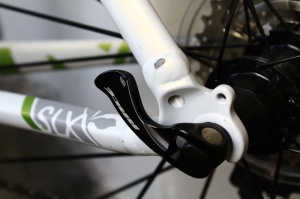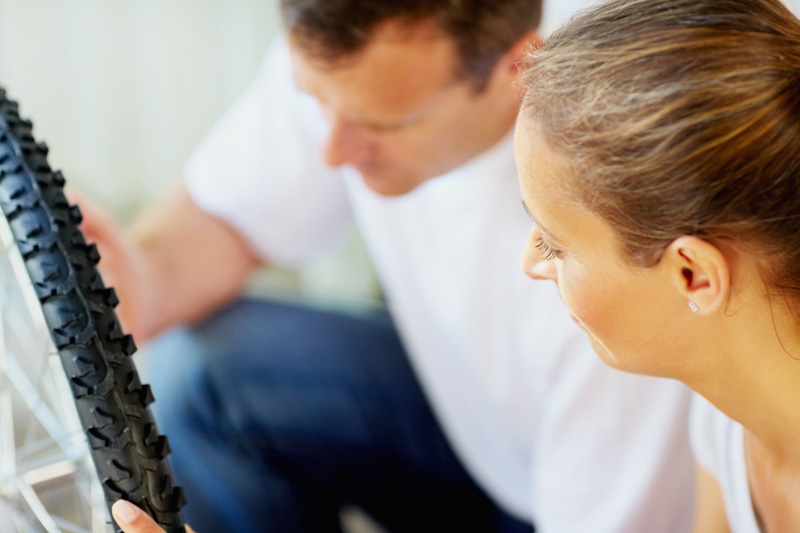Some bike maintenance jobs seem so basic that it’s assumed everyone knows how to do them well, but that’s not always the case, writes Stephen Huntley.
With instructions supplied with bikes and their parts often impossible to understand, and riders not wanting to feel foolish by asking what seem to be silly questions, seemingly simple tasks may never be learned.
Most things can be done with varying degrees of success in many ways, but experts who must perform tasks regularly usually learn the most efficient techniques. In this article we run through a couple of basic skills and talk you through how the experts do them.
 Securing quick release skewers
Securing quick release skewers
Quick release skewers for bike wheels have a great pedigree; they were invented by Italian rider and brilliant component innovator Tullio Campagnolo in 1927.
The skewers make taking your wheels on and off a very simple process, but it is still common to see bikes with their quick release incorrectly adjusted, which can be very dangerous.
The most commonly recommended steps to correctly install a quick release for the first time are as follows:
> Unscrew the quick release nut and slip off the spring closest to it.
> Thread the skewer through the wheel axle so the quick release lever and one spring are on the left-hand side of the bike. On the back wheel this ensures the lever doesn’t interfere with gear changing. The front wheel lever is traditionally on the left to match up with the back.
> When threading the skewers, note some tyres with tread are meant to face a certain direction. If your tyre tread has a ‘V’-type shape to it, the tip of the ‘V’ should be pointing towards the front of the bike (on some mountain bikes, the tread on the rear wheel may go in the opposite direction for added grip). If you’re not sure, look for an arrow pointing forward with a left/right mark on the tyre sidewall. It can be hard to spot, and many tyres aren’t marked. There’s no specific direction for slick tyres.
 > Put the spring back on the right hand side skewer, the small end of the spring pointing towards the wheel.
> Put the spring back on the right hand side skewer, the small end of the spring pointing towards the wheel.
> Screw on the nut a couple of turns then slide your wheel into the frame or fork.
> Line the wheel up with the centre of the frame, and hold the quick release lever pointing forward, parallel to the frame, in the open position. Most levers have a curve (dish); when the dish is in towards the bike, with its base close to the frame, it is open. Some levers have the words ‘open’ and ‘closed’ imprinted on opposite sides. You should be able to see the word ‘open’.
> Screw in the nut on the right hand side until you feel slight resistance, then try and close the lever by pulling it straight back towards the rear of the bike. As the lever comes up to be 90 degrees to the frame, you should start to feel some resistance. As you fully close the lever, and point it towards the rear, the pressure should be enough to leave a light mark on your palm. If it closes too easily, open it up fully again and tighten the nut some more.
> Why point the lever to the rear? The reasoning is that if you are riding on a trail and the lever is pointing forwards, it might get caught up in scrub and be pulled open. In reality, that is unlikely to happen, and many riders set it differently. One common position is to have the levers pointing up and just behind the front forks. On the rear wheel, many prefer to have the lever pointing forwards and upwards, sitting in the space halfway between the chain stay and seat stay. It can also look neat to have the quick release running up against the front fork, but on some bikes this will mean the quick release won’t fully shut, and if the lever rests too close to the frame, it can be harder to get your fingers underneath to open it again.
> When the lever is fully closed, the dish is curved with its base away from the bike frame (making it easier to get your fingers behind the lever when trying to open it), and the word ‘closed’ will be visible on some levers.
> If you’re riding behind someone and notice their quick release levers aren’t properly closed, politely warn them; you may help prevent an injury.
Some people are confused by the springs supplied with quick releases. The springs simply make fitting the skewer a bit easier by creating separation between the components. Don’t worry if you lose one or both, you can mount quick releases successfully without them, but it’s a slightly more fiddlier job.
Some riders never feel the need to take off their bike’s pedals, but it is a very easy thing to do, and it is surprising how often it can be handy.
For instance, if you’ve ridden to an event, and have to walk your bike through a crowd, you’ll find the pedals constantly being a menace both to your legs, and the legs of others. Whipping them off makes it far easier to negotiate.
When putting a bike in the back of a car, taking the pedals off can make getting it in and out a much quicker job. You can stack bikes up one against each other in your shed/garage/house very easily if the pedals are removed, and if you have to store your bike inside, taking off the pedals will make it much less of a hazard.
Removing the pedals can also make it that much harder for a would-be thief to take off on your precious machine.
So here are the steps for quick and easy pedal removal.
> There are special pedal spanners which are cheap to buy and will fit most pedals. They are the same as a 15mm spanner, but thinner. Many pedals can be taken off with a standard 15mm spanner, but for some the spanner head will be too thick.
> Warning: the right and left side pedals screw on and off in different directions. The right pedal screws in and out like a normal bolt; ie, righty tighty (clockwise turns to tighten) and lefty loosey (anticlockwise turns). But the left pedal screws in and out the opposite way, which can easily confuse. The reason behind the difference is that as you pedal and spin the pedals forward, both sides will automatically tighten. If the left-hand pedal screwed on in the normal direction, as you pedalled it would undo itself. Don’t let this panic you, however. There is a simple technique you can learn that will make the process simple.
> Whichever pedal you want to take off, stand on that side of the bike. Move that pedal and crank around so they are pointing directly forward, parallel to the ground. Attach your spanner, if possible, so that it is pointing slightly up and backwards, and resting just above the crank arm. Using the crank arm as an anchor, pull the spanner down towards it. Once you’ve cracked the initial tightness in the thread, continue spinning the spanner down, around and back towards the rear of the bike. The technique is exactly the same for both pedals.
> Before putting the pedals back on, apply a small amount of grease to the threads if they aren’t already well lubricated; it will help with future removals.
> Look closely at the threaded end of the pedal; somewhere, commonly at the top flat section of each pedal, you’ll see either an ‘L’ or an ‘R’ engraved. It is very important to make sure you screw the left pedal into the left side, the right into the right. It is not uncommon for riders to force a pedal onto the wrong side, stripping the thread in the process. This is an expensive mistake; a new crank arm will have to be bought.
> Once you’ve identified which pedal goes where, move to the side of the bike where you are going to reattach the pedal. Have the crank arm pointing directly forwards, and parallel to the ground, as when you took it off.
> Using fingers only, with thumb on the top of the pedal shaft, gently screw in the pedal, initially rotating the thumb forwards towards the front of the bike. Keep using your fingers to screw the shaft in until you can’t go any further. Then apply some light spanner pressure.
> Don’t use the spanner too early; it is easy to strip the thread if force is used and the thread isn’t correctly engaged.
> There’s no need to overtighten the pedals; be firm but not forceful.
> Once you get the hang of it, taking pedals on and off becomes second nature, and takes just a few seconds.
Ride On content is editorially independent, but is supported financially by members of Bicycle Network. If you enjoy our articles and want to support the future publication of high-quality content, please consider helping out by becoming a member.



I invented the reminder for myself: “righty righty, lefty wrongy” which reminds me that the left pedal is the one that does not behave as one might expect when trying to remove it.